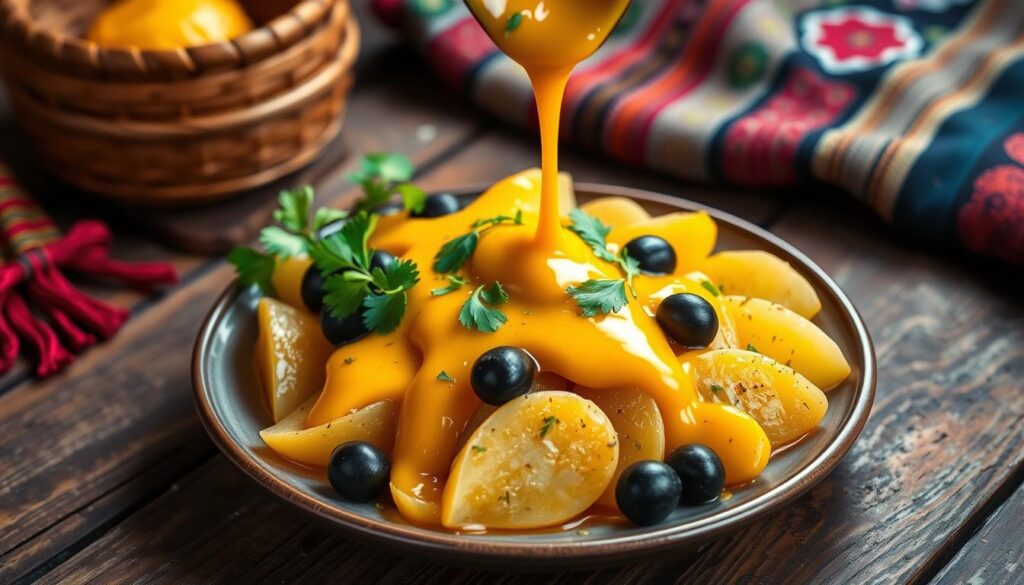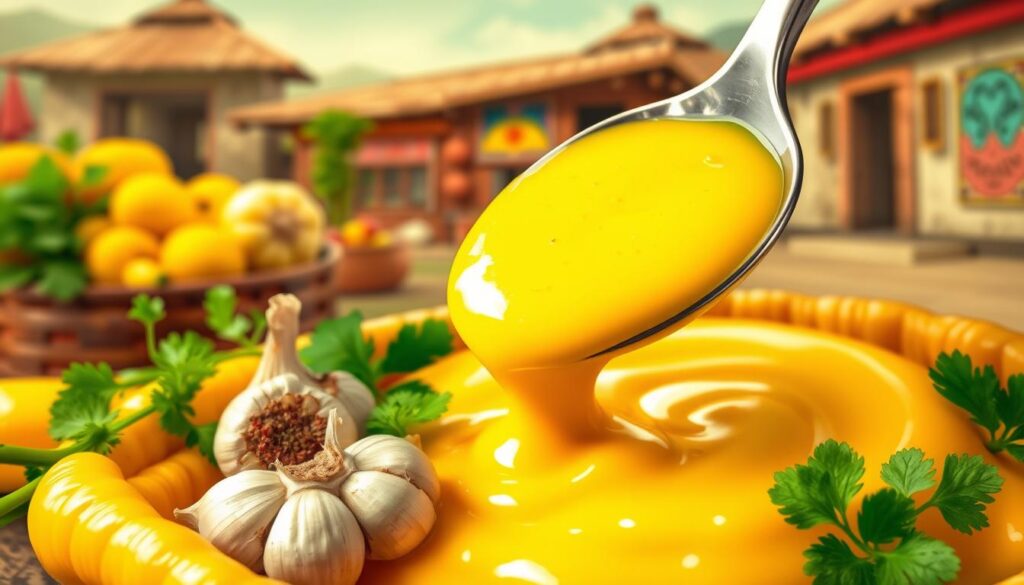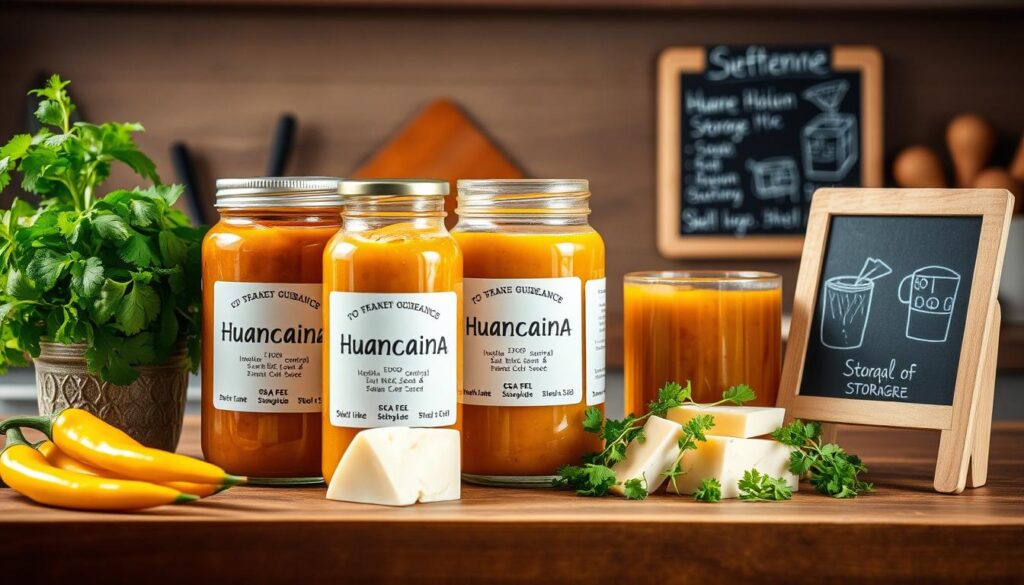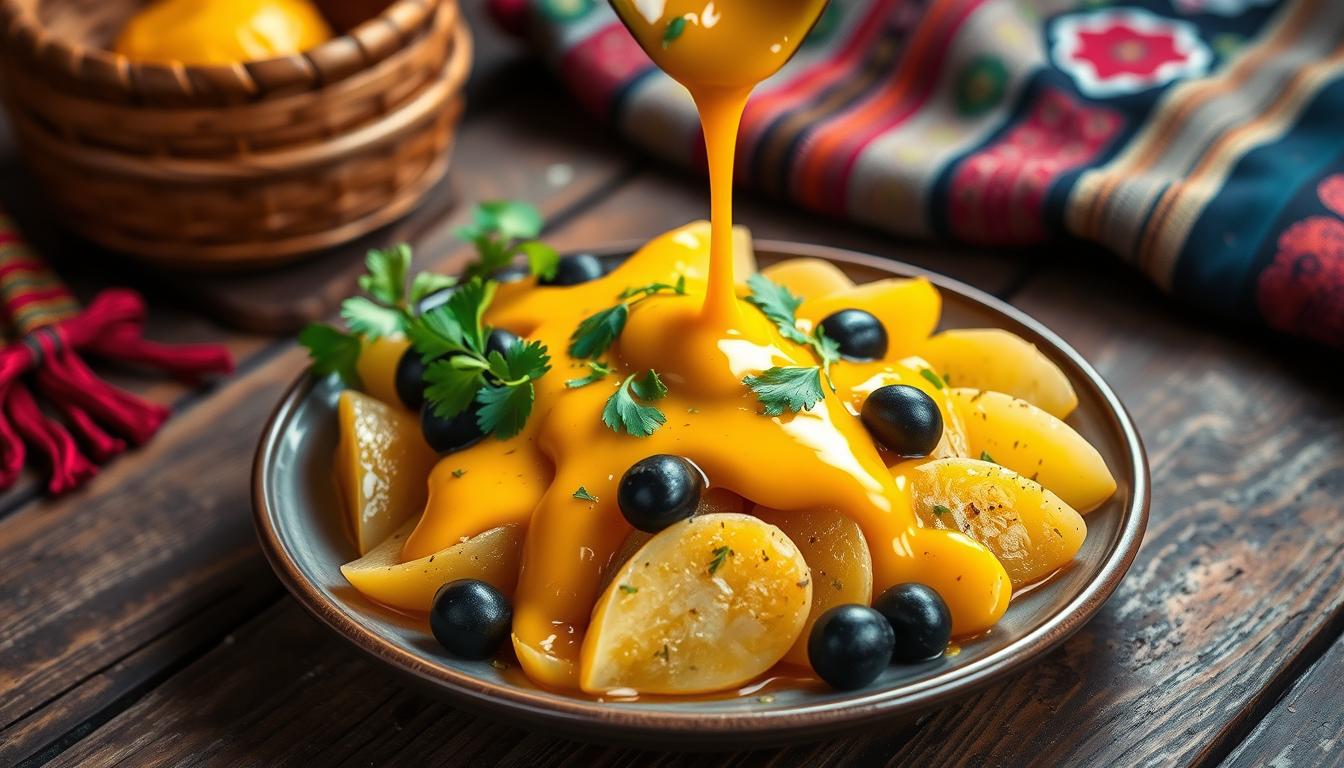
The first time I tasted Huancaina sauce, it was like finding a hidden treasure. The creamy, spicy mix took me straight to Peru’s lively kitchens. There, this famous sauce has been exciting people’s taste buds for ages. It’s more than a recipe; it’s a cultural journey waiting to be discovered.
Huancaina sauce comes from Huancayo, a high-altitude area. It was made for railroad workers to keep them nourished. Now, it’s a celebrated dish that shows off Peru’s culinary spirit.
What makes Huancaina sauce unique is its mix of ingredients. The aji amarillo chile pepper is the main attraction. It turns yellow when cooked, giving the sauce its bright color and spicy kick. With creamy queso fresco and a touch of garlic, it showcases Peru’s rich tastes.
Key Takeaways
- Huancaina sauce originated in the Huancayo region of Peru
- The sauce was initially created to feed railroad workers
- Aji amarillo peppers are the key ingredient in the sauce
- The sauce is incredibly versatile and can complement multiple dishes
- It represents a significant part of Peruvian culinary heritage
The Rich Cultural Heritage Behind Huancaina Sauce
Explore the world of Huancaina sauce, a dish that shows off Peru’s Inca heritage. This sauce has a story of innovation, culture, and creativity that spans many years.
Origins in the Huancayo Region
In Peru’s central highlands, the Huancayo region is where Huancaina sauce was born. It’s a sauce that became a national treasure. Local traditions and creative cooking turned simple ingredients into something amazing.
- Rooted in traditional Andean cooking techniques
- Developed by local cooks with limited resources
- Reflects the ingenuity of Peruvian cuisine
The Railroad Worker’s Connection
The story of Huancaina sauce is as interesting as its taste. A woman from Huancayo made this sauce for the workers building the Ferrocarril Central Andino railroad. Her recipe became a key food for those working in the tough Andean terrain.
“A simple sauce that fed the builders of Peru’s most challenging railroad”
Evolution into Modern Peruvian Cuisine
From its simple start, Huancaina sauce has become a key part of Peruvian food. Chefs and home cooks have made this Inca heritage dish famous. It went from a worker’s meal to a fancy national dish.
- Adapted by modern Peruvian restaurants
- Featured in high-end culinary presentations
- Celebrated as a symbol of cultural resilience
Now, Huancaina sauce is more than a sauce. It shows Peru’s rich food history, mixing old traditions with new cooking ideas.
Essential Ingredients That Create the Magic
Discover the magic behind Huancaina sauce, a vibrant Peruvian delicacy. It turns simple ingredients into a magical condiment. At its heart is the remarkable aji amarillo, a pepper that captures the essence of Peruvian cuisine.
The star ingredient, aji amarillo, is a unique chili pepper from Peru. These peppers change color when cooked, turning from orange to yellow. This gives the sauce its bright yellow color. With a fruity heat, aji amarillo peppers are more than spice – they’re a culinary signature.
Key Ingredients Breakdown
- Aji Amarillo Peppers: The primary flavor catalyst
- Queso Fresco: A creamy, crumbly white cheese
- Evaporated milk
- Saltine crackers
- Garlic
- Vegetable oil
Queso fresco is also key in the sauce’s makeup. This traditional Peruvian cheese adds a unique texture and mild flavor. It blends well, making the sauce smooth and creamy.
| Ingredient | Quantity (Standard Batch) | Purpose |
|---|---|---|
| Aji Amarillo Peppers | 3 peppers (seeded and chopped) | Primary flavor and heat source |
| Queso Fresco | ½ cup | Creamy texture and mild flavor |
| Evaporated Milk | ¾ cup | Smooth consistency |
| Vegetable Oil | ¼ cup | Binding and richness |
“In Peruvian cuisine, ingredients are not just food – they’re a celebration of culture and tradition.” – Peruvian Culinary Expert
Each ingredient in Huancaina sauce works together, creating a condiment that’s more than its parts. From the fiery aji amarillo to the creamy queso fresco, every part tells a story of Peru’s rich culinary heritage.
The Art of Making Traditional Huancaina Sauce
Making a creamy sauce is all about precision and passion. Huancaina sauce is a beloved dish in Peruvian cuisine. Each step needs careful attention.
To make this iconic sauce, you need to follow key techniques. These steps turn simple ingredients into a culinary masterpiece. Let’s look at the essential steps to make the perfect Huancaina sauce.
Gathering Your Ingredients
First, gather your main ingredients:
- 10 ounces of Peruvian Queso Fresco
- 3-4 tablespoons of ají amarillo paste
- 3/4 to 1 cup evaporated milk
- 4 saltine crackers
- 3 cloves of garlic
Sautéing and Blending Techniques
The secret to a great sauce is in the preparation. Start by heating oil in a skillet over medium heat. Sauté onions and garlic for 3-4 minutes until they become translucent. Then, add ají amarillo paste and cook until it turns vibrant yellow.
Achieving the Perfect Consistency
Blending is an art when making this sauce. Put your sautéed ingredients in a blender. Add evaporated milk slowly. Then, add queso fresco and crackers, blending until it’s smooth like yogurt.
“The magic of Huancaina sauce is in its creamy perfection and bold flavor.” – Peruvian Culinary Expert
Pro tip: To adjust the thickness, add more crackers or milk. The sauce should be like runny pudding, perfect for coating dishes.
Storage and Serving
Refrigerate your Huancaina sauce for 5-7 days. For the best flavor, chill it for 3-4 hours before serving. This sauce makes 8-10 servings, great for gatherings or meal prep.
Understanding Aji Amarillo: The Heart of Huancaina Sauce
Aji amarillo is the lively heart of Huancaina sauce. It adds spicy and tangy flavors that make this dish special. This yellow pepper turns a simple sauce into a work of art, showing off Peruvian cuisine’s best.
The aji amarillo’s special traits make it key in traditional recipes. Its heat can vary from mild to medium-hot. Chefs suggest using 1-2 tablespoons of its paste for the best taste.
“In Peru, aji amarillo is more than a pepper – it’s a culinary tradition passed through generations.”
Sourcing Aji Amarillo
Getting fresh aji amarillo peppers outside Peru can be hard. But, you have a few options:
- Purchase jarred aji amarillo paste online
- Order through specialty food retailers
- Use Amazon as a convenient purchasing platform
Nutritional Insights
| Characteristic | Details |
|---|---|
| Heat Range | Mild to Medium-Hot |
| Recommended Usage | 1-2 tablespoons paste |
| Nutritional Impact | Low calorie, high flavor |
Learning about aji amarillo lets you make a true Huancaina sauce. It takes you on a flavor journey to Peru.
Cheese Varieties and Their Impact on Flavor
The world of cheese is vast, with over 1,800 types globally. Choosing the right cheese can change your dish, especially in Huancaina sauce.
Traditional Queso Fresco: A Peruvian Delight
Queso fresco is key for real Huancaina sauce. It’s a fresh, mild cheese with a unique texture and flavor. Its softness makes the sauce smooth and rich.
Modern Cheese Substitutions
Not all can find queso fresco. But, you can try other cheeses that work well:
- Cottage cheese
- Cream cheese
- Feta
- Ricotta
Texture and Melting Properties
| Cheese Type | Melting Time | Flavor Profile |
|---|---|---|
| Fresh Mozzarella | 2-3 minutes | Rich, milky |
| Cream Cheese | 1-2 minutes | Smooth, mild |
| Cottage Cheese | 3-4 minutes | Tangy, light |
Your cheese choice greatly affects your Huancaina sauce’s texture and taste. Try different cheeses to find your favorite!
“Cheese is milk’s leap toward immortality.” – Clifton Fadiman
Pro tip: When replacing queso fresco, pick cheeses with similar moisture and mild taste. This keeps the Huancaina sauce true to its roots.
Nutritional Profile and Health Benefits

Exploring Huancaina sauce’s nutrition shows it’s more than tasty. It’s a mix of nutrients that can boost your diet. This sauce is a true culinary treasure.
The main ingredients of Huancaina sauce are packed with nutrients. Let’s look at what makes it special:
| Nutrient | Amount per Serving |
|---|---|
| Calories | 194 |
| Fat | 14g |
| Carbohydrates | 8g |
| Protein | 9g |
The sauce’s main ingredient, aji amarillo peppers, has many health benefits:
- Rich in vitamin C for immune support
- Contains antioxidants that combat free radicals
- May support metabolic health
- Potentially aids digestive processes
“Huancaina sauce represents more than a condiment – it’s a nutritional journey through Peru’s culinary traditions.”
While it’s tasty, enjoy it in moderation. The sauce has a lot of fat. So, balance it with lean proteins or veggies. This way, you can enjoy South American flavors without overdoing it.
Creative Ways to Serve and Enjoy Huancaina Sauce
Huancaina sauce is a versatile dish from Peruvian cuisine. It can make any meal special. Its creamy texture and unique taste make it exciting for home cooks.
Traditional Pairings
In Peruvian cuisine, Huancaina sauce goes well with classic dishes like papa a la Huancaína. It’s drizzled over boiled potatoes, creating a delicious mix of flavors.
- Boiled potatoes
- Hard-boiled eggs
- Lettuce salads
- Steamed vegetables
Modern Applications
Huancaina sauce is very adaptable. It can make simple meals taste like gourmet dishes.
| Dish Category | Serving Suggestions |
|---|---|
| Pasta | Use as a sauce for spaghetti or fettuccine |
| Proteins | Drizzle over grilled chicken or fish |
| Snacks | Serve as a dip for yucca fries or tortilla chips |
International Fusion Ideas
Try Huancaina sauce in international dishes. It’s perfect for mixing Peruvian flavors with global cooking styles.
- Spread on sandwiches
- Use as a pizza topping
- Mix into risotto
- Pair with barbecue dishes
“Cooking is about passion, creativity, and the joy of sharing flavors from around the world.” – Anonymous Chef
Storage Tips and Shelf Life Recommendations

When you make Huancaina sauce, knowing how to store it is key. It keeps the sauce’s flavor and safety top-notch. Your homemade Huancaina sauce needs special care to keep its taste and texture just right.
Here are the main storage tips:
- Store in an airtight container
- Refrigerate immediately after making
- Keep at temperatures between 32°F – 40°F
- Use within 2-3 days for the best taste
Watch out for these signs of spoilage:
- Unusual color changes
- Separation of ingredients
- Unpleasant odor
- Visible mold growth
“Fresh is best when it comes to traditional Peruvian sauces!” – Peruvian Culinary Experts
To store longer, freeze the sauce in small parts. Freezing keeps the sauce fresh for up to a month. This way, you can enjoy its true flavor longer.
| Storage Method | Duration | Recommended Conditions |
|---|---|---|
| Refrigerated | 2-3 days | Airtight container, 32°F – 40°F |
| Frozen | Up to 1 month | Sealed freezer-safe container, 0°F |
Pro tip: Always label your container with the preparation date to track freshness!
Conclusion
Your journey into huancaina sauce shows a vibrant treasure from Inca heritage. It comes from Huancayo, Peru, and is more than a sauce. It’s a story of Peruvian food that links people through taste and tradition.
Huancaina sauce is at the heart of Peruvian food, making simple things special. It’s perfect for both traditional dishes and new recipes. It’s loved in family meals and fancy places like Astrid y Gaston.
Making huancaina sauce lets you connect with Peru’s food culture. Learning about its ingredients and making it can improve your cooking. It also helps you appreciate the unique tastes of Peruvian food.
Discovering huancaina sauce is a journey into Peruvian food’s creativity and passion. With this knowledge, you can explore and enjoy the amazing flavors of Peruvian cuisine.
FAQ
What exactly is Huancaina sauce?
Huancaina sauce is a creamy, spicy Peruvian condiment. It’s made with aji amarillo peppers, queso fresco, and saltine crackers. It’s from the Huancayo region and is often served over boiled potatoes.
Where did Huancaina sauce originate?
It comes from the Huancayo region in Peru. It has a rich history tied to railroad workers who first made it. Now, it’s a key part of Peruvian cuisine.
What are the key ingredients in Huancaina sauce?
The main ingredients are aji amarillo peppers, queso fresco, evaporated milk, and saltine crackers. Garlic and salt are added too. The aji amarillo gives it a unique yellow color and flavor.
Is Huancaina sauce spicy?
It’s mild to medium-hot. The aji amarillo pepper adds a warm, flavorful heat. It’s not too hot for most people.
How can I make Huancaina sauce if I can’t find aji amarillo?
Use jarred aji amarillo paste if fresh is hard to find. You can also mix yellow bell peppers with a bit of habanero for heat.
What dishes can I serve Huancaina sauce with?
Serve it over potatoes, or use it as a dip. It’s great on sandwiches or as a topping for chicken or fish.
How long can I store homemade Huancaina sauce?
Store it in an airtight container in the fridge for 3-5 days. Always check for spoilage before using. Fresh batches taste best.
Is Huancaina sauce vegetarian?
Yes, traditional Huancaina sauce is vegetarian. But, check recipes for any non-vegetarian ingredients.
Can I freeze Huancaina sauce?
You can freeze it, but the texture might change. Freeze in an airtight container for 1-2 months for the best taste.
Is Huancaina sauce healthy?
It has nutrients from peppers and cheese. But, it’s high in calories and fat. Enjoy it in moderation for a balanced diet.

